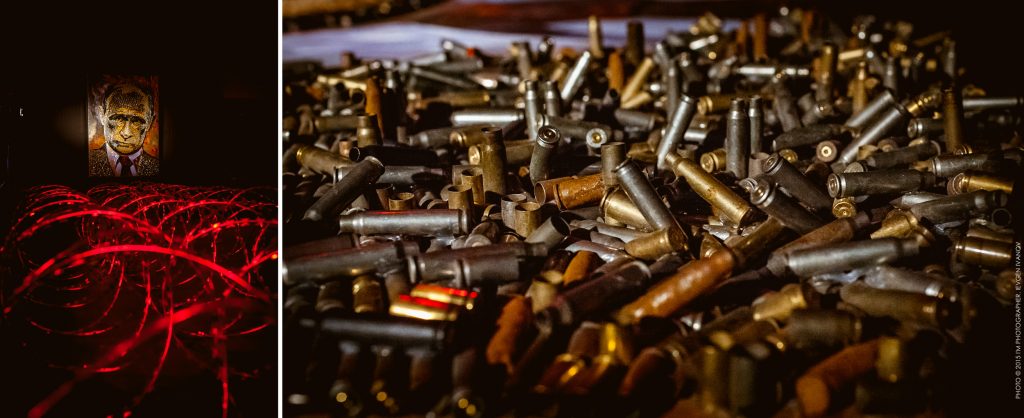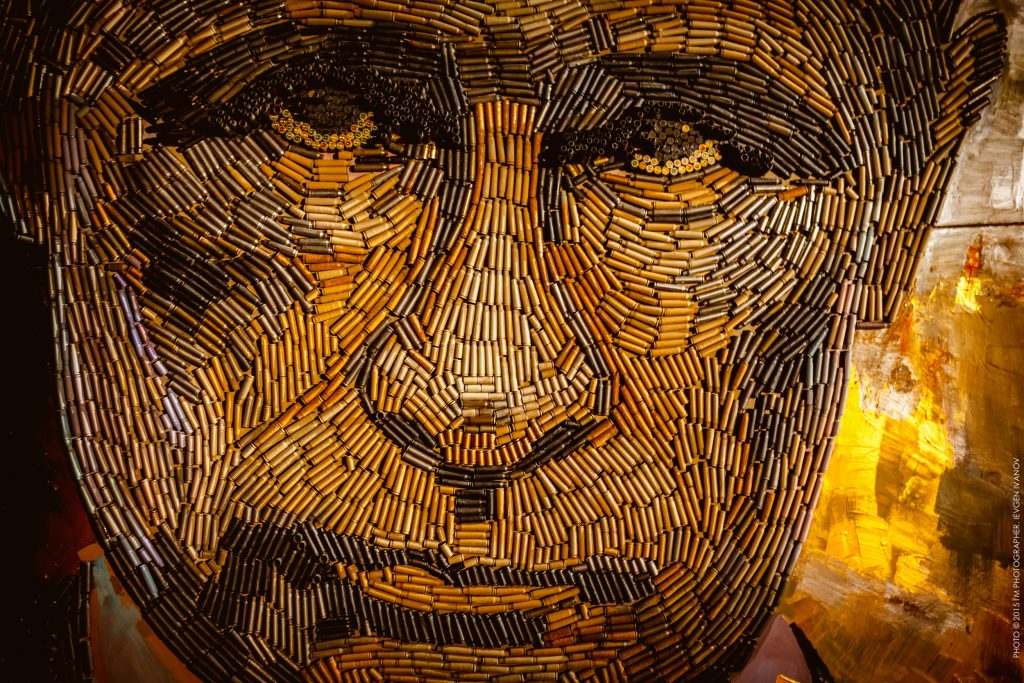On 25 August, the M17 gallery hosted a public presentation of the mosaic exhibit, “Faces of War.” Although it was displayed in only one studio, images of the exhibit were broadcast by nearly every international media outlet and published in over 2,000 publications such as the Guardian, Herald, Times and the Wall Street Journal. Daria Marchenko, the author of “Faces of War,” exposes the brutality and hypocrisy of the Kremlin in order to show the international community the architect of the occupation of eastern parts of Ukraine. The date of the presentation marks the anniversary of the Russian open military invasion that culminated in the Ilovaisk tragedy.
Visitors had to enter the exhibition hall alone. While heading down a long corridor surrounded by barbed wire and dark-red lighting, visitors could experience the multi-faceted nature of war depicted in the ever-changing portrait of Russian President Vladimir Putin. The unique mosaic exhibit is composed of 5,000 shells brought from the Anti-Terrorist Operation (ATO) area in Ukraine’s East. The portrait of Russia’s authoritarian leader changes colors and facial expressions depending on the angle of lighting. However, even the rich and emotional amplitude of the portrait does not distract the viewer from the terrible truth manifested in the deadly metal material from which the work was created.
Artist Daria Marchenko commented on the installation: “It is Vladimir Putin who is responsible for the war in eastern Ukraine. He has violated the 1997 Budapest Memorandum and cynically spreads a flawed picture of the conflict as exclusively internal in nature. When we gave up our nuclear weapons in exchange for Ukraine’s security guarantees from Russia, the United Kingdom and the United States, the whole world witnessed promises to respect Ukraine’s independence, sovereignty and territorial borders. Russian aggression gravely violated the fundamental norms of international law. In fact, a country that had promised to protect us has instead brutally attacked us. Our servicemen are dying not only for Ukraine, but also for the very concepts of honor and respect of these agreements, without which the global arms race would have continued. And that is why the world’s media treated my exhibit, which exposes the falsity of the Kremlin elites, so respectfully. Such a passionate reaction demonstrates the level of outrage of the world community and their support for Ukraine.”
The exhibition brought together volunteers, opinion leaders, diplomats, representatives of political and cultural elites, as well as friends of the artist who had brought the shells from the frontline. Daria Marchenko thanked Oleg Hladkovskiy, politician and the project’s benefactor, as the event became a platform for social dialogue and new understanding of the modern history of Ukraine.
Yuri Michalski, a fighter of the “Donbas” volunteer battalion who fought against Russian troops in the battle of Ilovaisk, shared his own sentiments. He is one of the few who survived and came back from the ATO area after being gravely wounded.
Iryna Gerashchenko’s speech resonated with deep feeling, as. at the time of the Ilovaisky tragedy she was in the ATO area. “On August 25, 2014 Russian troops invaded Ukraine. They began shooting at our heroes near Ilovaisk. On August 25, 2015, the Russian court of justice sentenced Ukrainian heroes to 20 years of imprisonment … Putin’s August escalation … Now, we see the face of a serial killer made out of the very bullets that he sends to Ukraine. Whatever expression this face takesm for all Ukrainians it will be the face of war.”
The war, one way or another, has affected many of those present in the hall. One common topic was thread through in a variety of speeches: the role and impact of culture on peace building and the need for unity, as Ukraine desperately needs these qualities to withstand its aggressor.
At the end of the evening, Daria Marchenko announced the release of her book, which consists of seven stories “about my boyfriend, the centurion of the barricades on Instytutska street, about my friends – founders of the volunteer headquarters, about a Ukrainian soldier – “cyborg” – from the Donetsk airport, about the men who survived Ilovaisk, about one of the best snipers Ukraine and about my friend on the frontline. The book is about all those who have provided me with such “fatal colors,” and who have seen “the Faces of War” much closer than myself. It is about all those who lived a quiet life until the moment they attacked us. I still believe that you can reach their hearts and minds. And I want the world to learn the truth,” concluded Daria Marchenko.





